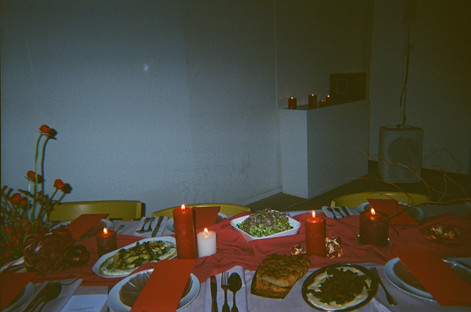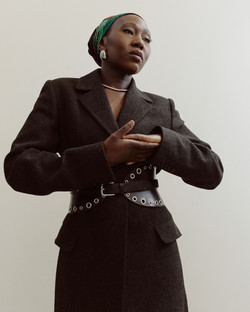UMA SOCIETY: Claiming Space, Uplifting Women & Preserving Culture
- Taylor Bennett
- Oct 6
- 6 min read
In conversation with
Taylor Bennett (Founder) TFB Magazine | TFB Collective
& Treshna Ballantine (Founder) UMA Society
At TFB Magazine, we believe in the power of cultural storytelling to shift industries forward. As international creative networks expand, diasporic voices and community-driven initiatives are redefining how art, culture, and representation reach global audiences. We are proud to sit down with Treshna Ballantine, the founder of UMA SOCIETY a platform dedicated to empowering underrepresented women in culture, media, and art, to discuss her newest exhibition, KAN KAN UMA, and the importance of uplifting peers as a path to industry-wide growth.
UMA SOCIETY’s Origins
TFB: Treshna, you describe yourself as a multidisciplinary maker, and UMA SOCIETY emerged from your own creative journey. Can you share what pushed you to create UMA and why it felt necessary in the current cultural landscape?
UMA: To be honest, I’ve always known that I wanted to do something in the creative industry. I wanted to become a fashion journalist and along the way when I was a teenager I started blogging with friends and the idea of a women’s platform was already there. The lack of diversity and opportunities for BIPOC creatives is the reason it always felt necessary to create something.
I’m just tired of asking to be seen. I see myself and I see the talented women that are out there. So might as well do it how I want it to be and to stop asking for permission or validation.
The Exhibition – KAN KAN UMA
TFB: The title means “a proud woman” in Sranantongo. What inspired you to create this exhibition, and how does it reflect both your personal identity and your wider community?
UMA: For the past three years my research on my identity sparked the interest. Last October, I went to Suriname after 19 years and it was very wholesome. The disconnect that I had for a while, completely shifted in actually appreciating and loving my culture. I literally fell in love with the peace that I felt at home.
The project is very personal and it reflects my own journey of reconnecting with my Surinamese roots and identity but at the same time it represents something larger. KAN KAN UMA is about how we, as women of the diaspora, embody pride and beauty, while creating space for new generations to see and embrace themselves.
TFB: You’ve chosen to collaborate with women makers across disciplines, photography, styling, textile art, audio-visual work. Why was it important for you to center this project in collaboration?
UMA: The whole core of UMA SOCIETY is to collaborate and create opportunities for each other. With every project I need other people. I couldn’t do it just by myself. Especially with this project. It’s important that we support each other's talent.
Diasporic Storytelling & Heritage
TFB: Many younger generations of the Afro-Surinamese and Indigenous diasporas feel disconnected from traditions. How do you hope KAN KAN UMA bridges the gap between older and younger generations?
UMA: It starts with representation. We are used to our history being told from a perspective that we only talk about slavery. While we should never forget that, it’s also time to write a new chapter and see the beauty and resilience in our culture. KAN KAN UMA is bridging the gap to start conversations between these generations.
TFB: What role do you think exhibitions like this play in preserving cultural memory while also reimagining it for the future?
UMA: Exhibitions like this act as both an archive and a vision. They preserve cultural memory by honoring our values, traditions, stories, identities that are being overlooked or even forgotten. On the other hand, they reimagine these memories through contemporary perspectives, showing that culture is not static, but always evolving, and relevant for future generations. In that way, the past becomes a foundation for innovation.
International & Industry Perspective
TFB: UMA SOCIETY isn’t just about representation; it’s also about giving underrepresented women the tools and visibility to lead within the cultural and creative industries. How do you see projects like KAN KAN UMA impacting the larger international creative industry?
UMA: I really LOVE this question. UMA SOCIETY wants to expand internationally and I want to create opportunities with other creatives or brands. The Netherlands is way too small to think big sometimes. So I rather expand my vision.
I hope this exhibition is impacting a larger audience to keep telling stories about their culture, their people, their traditions and don’t forget where we come from. Also I would love to introduce Surinamese culture in a different cause some countries have never heard of it.
TFB: At TFB, we believe that inclusivity and collaboration bring real, organic growth to industries often obsessed with exclusivity. How do you see your work pushing against that exclusivity and offering a new model?
UMA: I’m choosing collaboration over competition and by centering communities that are too often left out of the narrative. UMA is built where creativity is accessible. Also by showing that you can produce high-quality, visionary work while also being inclusive and fair. And one of the biggest things: No gatekeeping.
Community, Collaboration & Uplifting Peers
TFB: One of UMA’s strengths is the way it uplifts peers and ensures that collaborators are fairly compensated. Why is this value so central to your platform?
UMA: It is central because women are often undervalued. The core of UMA is to have peers and collaborators in the industry get fair changes or fair compensation. We are working on building a culture where creatives can thrive. It’s about respect, equity, and showing that collaboration becomes so much stronger when everyone feels seen and rewarded for their contribution.
TFB: Can you share how your peers and collaborators have uplifted you in building UMA?
UMA: They have uplifted me by supporting my vision. The projects that I’m doing are all in collaboration and you see how everyone is enjoying it. I love working on set with women. It feels safe, empowering and just motivating.
Looking Forward
TFB: This exhibition launches on November 22, a significant date marking OSCAM’s 8th anniversary and 50 years of Surinamese independence. What does that timing mean to you?
UMA: The timing couldn’t be more meaningful. I wanted to do an exhibition for a long time but didn’t really know when. To present KAN KAN UMA during the 50th anniversary of Suriname Independence is a way to honor my ancestors, my culture and my identity. Also doing this with OSCAM’s 8th anniversary, a space that has consistently championed representation and culture, makes it even more powerful.
TFB: Beyond KAN KAN UMA, what’s next for UMA SOCIETY? Where do you see the platform growing in the next few years?
UMA: I have a lot of ideas for UMA. One of my goals that I’m not afraid to say out loud, is to give back to my community by building something in Suriname as well.
Closing Reflection
TFB: For young women in the diaspora or underrepresented voices in the creative field, what advice would you give about carving space and building community within industries that don’t always make room?
UMA: Claim your space, don’t wait to be accepted or wait for validation. You need to believe that you are meant to build strong spaces on your own. Trust in your own craft and keep getting better at it. To be honest when you are the biggest cheerleader, you will see the rest will follow.
UMA SOCIETY’s work with KAN KAN UMA shows us that heritage and innovation are not opposites, but partners in building up our collective creative future.
Now, it’s our turn as readers, peers, and change-makers to uplift the women around us, to celebrate diasporic voices, and to support platforms that make space where none existed before.
Want to Learn more about UMA SOCIETY and support the next chapter of KAN KAN UMA ? Click the button(s) below to make an impact today!
Stay Connected. Stay Curious.
Explore more stories that bridge creativity, culture, and community across the U.S., the E.U., and beyond.
Join the world of TFB — subscribe via our homepage and follow along @tfbmag | @tfbcollective
Shoot Credits:
Photography Angela Huizer (@angelahuizer)
Creative Direction Treshna Ballantine (@treshnaleida)
Interview Alina Sosina (@alinasosninaa)
Styling Athitaya (@a.thi.taya)
Face by Gigi Perez (@artebyperez)
Dinner by: UMA







































Comments